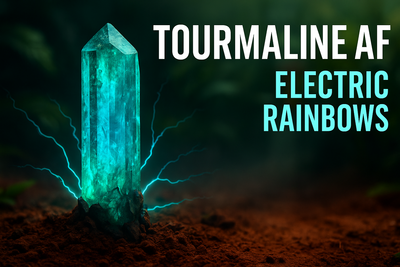Tourmaline AF: Electric Rainbows & Neon Madness
Gallery Gems on 4th Oct 2025
October doesn’t just belong to opal. Its alternate birthstone — tourmaline — is every bit as wild, unpredictable, and misunderstood. Forget “just another colorful gem.” Tourmaline is electric, rainbow-mad, and scientifically bizarre in ways no other stone even comes close to.
This is Tourmaline AF.
✦ The Electric Stone
Tourmaline isn’t just colorful — it’s literally electric. Heat it, rub it, or even just touch it, and it builds an electric charge strong enough to attract dust, ash, or even little scraps of paper. Ancient Sri Lankan traders noticed it centuries ago. Dutch merchants in the 1700s nicknamed it aschentrekkers — “ash pullers” — because it could pull ash right out of their tobacco pipes.
Science later proved the hype: tourmaline is both pyroelectric (charged by heat) and piezoelectric (charged by pressure). Translation? It bends energy.
✦ A Rainbow Gone Mad
Other gemstones are limited to a handful of hues. Tourmaline? It’s chaos incarnate. It comes in nearly every color imaginable — pink, red, green, yellow, blue, purple, brown, black, bicolor, tricolor.
But the madness doesn’t stop there. Tourmaline also spans a huge range of shades and tones within those colors — from soft, pastel mints and delicate baby pinks to saturated neons, forest greens, fiery magentas, and almost-black indigos. Collectors prize not just the hue, but the saturation, tone, and intensity that make each stone unique.
The most famous example? Watermelon tourmaline, with its green rim and pink heart, a natural masterpiece of color zoning that looks like summer captured in stone.

✦ Royal Impostors
For centuries, tourmaline passed as ruby and sapphire in crown jewels. Many “rubies” in Russian royal collections were later revealed to be red tourmaline. To this day, the gem world still debates what counts as true “rubellite” — the electric red that glows like embers even in low light.
Tourmaline didn’t just sneak into royal vaults — it stayed there.
✦ Paraíba: The Neon Revolution
Then came the discovery that changed everything. In the late 1980s, miners in Brazil uncovered a type of tourmaline no one had seen before: glowing electric-blue and neon-green stones, lit by copper and manganese.
Called Paraíba tourmaline, it skyrocketed from obscurity to $20,000+ per carat in just a decade. Today, Paraíba remains one of the most sought-after gemstones in the world — rarer than diamond, rivaling sapphire, and instantly recognizable.
✦ Names That Tell the Story
Tourmaline isn’t one stone — it’s a vast family of minerals, and both mineralogical names and trade names reveal just how wild it really is:
-
Elbaite: The superstar of gem-quality tourmaline, covering everything from pinks and greens to blues and multicolors.
-
Indicolite: Rich, saturated blue stones that rival sapphire.
-
Rubellite: Deep red gems, once mistaken for rubies in royal collections.
-
Verdélite: Vivid green crystals, sometimes confused with emerald.
-
Achroite: Rare, colorless tourmaline — nearly invisible, a collector’s prize.
-
Paraíba: Copper-bearing neon electric blues and greens that rewrote gemstone history.
-
Chrome Tourmaline: Intensely vivid green, colored by chromium, often rivaling tsavorite garnet.
-
Liddicoatite: Rare, kaleidoscopic multicolor crystals named for gemologist Richard Liddicoat.
-
Dravite: Brown to golden hues, unusual but fascinating for collectors.
-
Uvite: Denser crystals in deep green to brown shades, cut into unusual gems.
-
Schorl: The opaque black giant — historically used as a protective talisman and still a favorite in metaphysical circles.
The names alone read like a family tree of color and character — each with its own mystique, market, and mania.
✦ Mystics, Shamans & Sorcery
Tourmaline’s bizarre energy made it a favorite of shamans and mystics. Some believed it could protect against toxins, ward off demons, or even reveal truth. In India, it was prized as a “reconciliation stone,” bringing enemies into harmony. In Africa, it was used as a stone of awakening and insight.
It wasn’t just a gem — it was a weapon of spirit.
✦ Chaos for Cutters, Heaven for Collectors
Collectors love tourmaline for its variety. Lapidaries? They wrestle with it. Tourmaline crystals are often dichroic — showing two different colors or intensities depending on the angle. That means every decision in cutting changes how the gem looks.
Cut along one axis, and you get a bright, lively hue. Cut another way, and you might end up with something darker or muddier. For the skilled lapidary, it’s an opportunity to coax neon fire and sharp saturation. For the unskilled? It’s a disaster waiting to happen.
That unpredictability is exactly why top-quality tourmalines are so coveted — they’re not just mined, they’re mastered.
✦ Tourmaline AF
Tourmaline isn’t “just” opal’s understudy. It’s a gemstone that glows with impossible neon fire, shifts with energy, and carries more colors than any other mineral on Earth.
It’s rainbow chaos with an electric edge.
Explore gemologist-certified tourmalines at Gallery Gems — where even October’s alternate birthstone gets treated like a legend.
